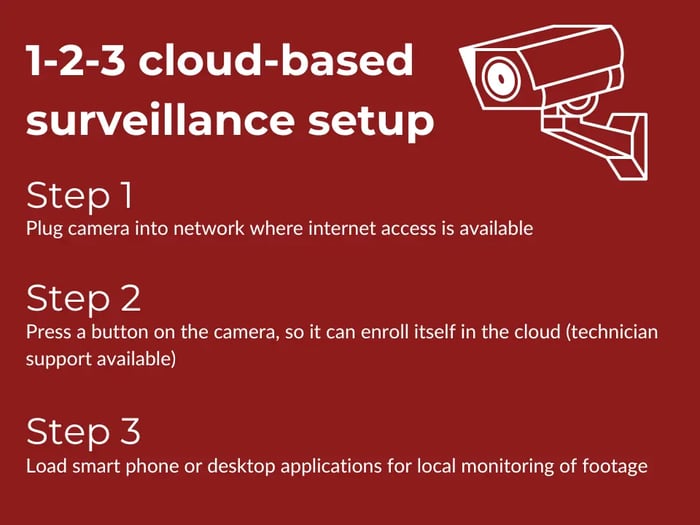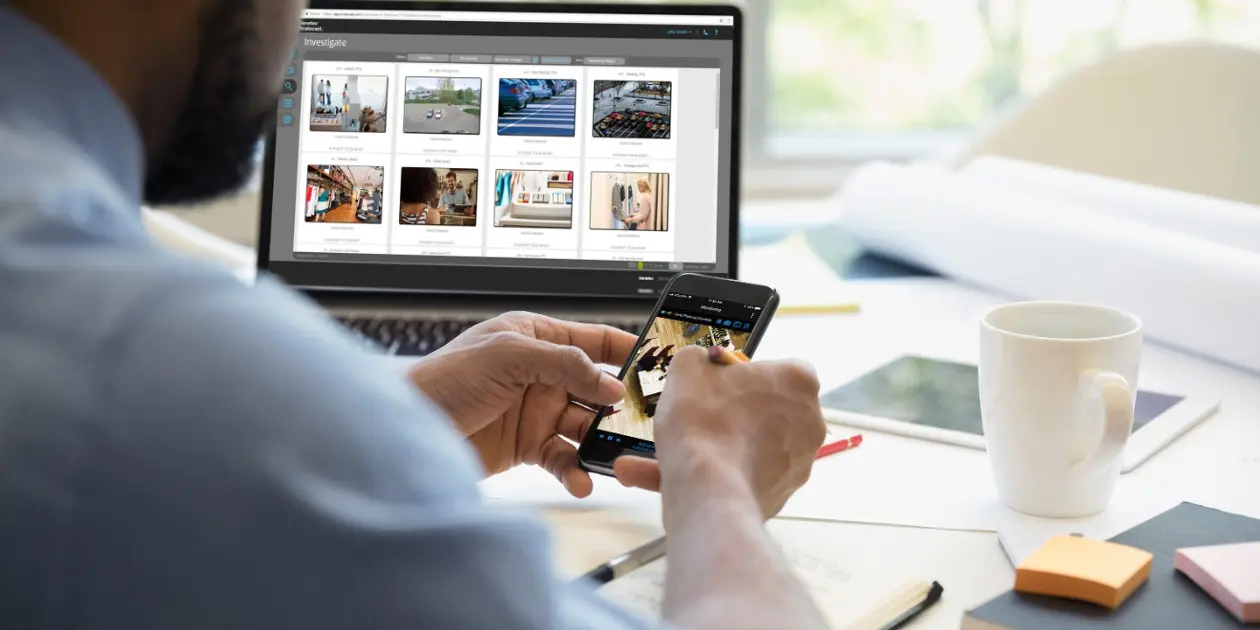Everything you need to know about cloud-based security
A multilocation security solution comes down to two needs: (1) use hardware and software to prevent theft and (2) make it cost effective. In the past, these two needs have pushed against one another — the more effective the loss prevention, the higher the price of the hardware, software and services needed.
Now, with the adoption of cloud solutions for physical security the two targeted needs are getting closer aligned. In other words, the best technology is improving effectiveness and getting less expensive in certain scenarios.
Are cloud-based solutions right for your enterprise? Brian Freeman, Vice President with Prime Secured, said it depends. “Using cloud applications for physical security is not right for everyone. The common belief is that everybody’s doing everything in the cloud, but there is a point where the technology is prohibitive based on the size of the application.”
This article discusses the benefits of cloud-based video management for physical security, explains how it works, and provides three scenarios to help you visualize how such a system might be used in your operation.
|
What are the benefits of cloud-based physical security systems? |
|
A Checklist to know if cloud-based security is right for you |
What exactly is cloud-based physical security?
Until recently, most multilocation retail stores with IP based security systems placed security hardware and software on premise, sometimes with monitoring capabilities at a central location where staff could analyze footage. The hardware consisted of a standalone server and hardwired cameras for each store. Some retail operations integrated cameras with access control platforms and/or facial recognition software.
This kind of security system setup can be expensive, especially when hardware is needed for hundreds of locations. It’s tempting to buy cheap hardware to get the capital expense as low as possible. However, as Freeman points out, it’s true what they say about getting what you pay for, and repair needs are more likely and more frequent when you settle for less-expensive equipment.
He explained, “When there are problems with surveillance on location, you may need a Level I tech support for repair, and you have to wait for the provider to send a technician out on a truck, which means a trip charge and an hourly rate.” Multiply that by a percentage of stores that need this service annually, plus the cost of regular maintenance and replacement of hardware in all stores, and the cost can add up very quickly.
The latest cloud-based technology options eliminate the need to provide physical hardware (other than cameras) at every store. New systems use relatively inexpensive IP cameras connected to cloud-based systems that can be monitored by store managers and/or by corporate security personnel using security as a service (SaaS) systems accessed by mobile and desktop devices.

A sample of Genetec's Stratocast, a cloud-based security platform, is depicted above. The diagram shows the path of video data from IP cameras through the cloud and SaaS applications to mobile and desktop monitors, which can be located anywhere.
One of the first barriers to upgrading systems is often a distrust of the quality of new technology. But with recent technological advances, cloud-based physical security systems now work as well as you might hope, and they have proved to reduce costs for certain types of retail operations.
Dustin Graybill, Prime Secured’s Senior Systems Engineer says the cost breakpoint for such systems occurs at about 10 cameras per store. In other words, installing 10 or fewer IP cameras at a retail site using a SaaS application costs less on average than operating a site-specific server and cameras.
Here is how Freeman and Graybill break down the benefits of SaaS systems for those configurations:
Benefits of cloud-based physical retail security systems
1. Cloud-based technology is cost-effective
Prime Secured records show that it’s less expensive to deploy and maintain per-device subscription services for cloud-based video storage for 10 or fewer cameras than it is to deploy and maintain an on-site server and hardwired cameras. According to Graybill, the greatest portion of this cost savings comes from relatively recent reductions in the cost of storing video footage in the cloud — about half of what it used to be. This is in part due to advanced compression technology, which means more footage can be stored in less space. He said these advantages have led to cloud-based services that are now about four times less expensive than they were even a year ago.
2. Fast deployment
IP cameras are by nature faster to set up than analog cameras. All that’s required is an adequate Internet connection, POE network switch, mounting hardware and desktop or mobile device monitoring applications. When it comes to registering cameras to the security system and connecting them with the network, all you have to do is push a button. All the hard work behind the scenes is handled by cloud-based services IT staff, who are experts (fast and smart) at deploying your specific technology.

3. Maintenance
With cloud-based physical security systems, installation and maintenance is left to the provider, which leaves store personnel — and home office IT personnel — free to spend time on more important tasks. This can be especially helpful in a retail setting. Freeman points out, “You don’t want to take managers and employees away from a potentially paying customer in the store to see if the cord is plugged in.”
4. Easy system conversion
In many cases, a retail location would like to make use of new IP technology and cloud-based services but doesn’t believe it can justify the cost of retiring legacy systems. However, IP security hardware is easy to add to existing systems. Also, analog cameras can be converted for use with cloud-based solutions within minutes using video encoders. This helps preserve the initial investment in analog security cameras. “You can easily add on cloud-based features as your budget allows to reproduce anything traditional systems offer,” Graybill said. “This makes it possible to smoothly move from analog to cloud-based security.”
5. Flexible use
Because IP cameras are connected to the network anywhere within range of the Internet, the cameras can be moved at will. This allows store managers to cover hotspots within the store where problems appear. Cameras can be placed by entrances, cash registers and high-priced merchandise, as well as in storerooms and offices.
3 use-case scenarios for cloud-based retail physical security
Donut shop chain enhances legacy security systems
This company operates many small donut shops across the United States. Each store has between two and four physical areas that need monitoring by security cameras. The legacy security system within all of the stores used to consist of an on-site server and analog cameras that required ongoing maintenance, testing and troubleshooting by local store managers who do not have IT backgrounds. Therefore, complicated repairs required expensive third-party IT services. As the systems aged, the company’s customer service leaders became aware of an ongoing issue with staff leaving their posts to deal with security system problems. Deployment of a purely cloud-based system with all IP cameras throughout all locations would have been too costly and time consuming for this company, so corporate IT leaders hired a provider to convert legacy analog cameras to a new central SaaS system that can be accessed by both store managers and corporate staff. This has eliminated most third-party costs for repairs, given corporate staff access to video feeds from every store, and put managers back on the retail floor. An unexpected benefit of having video feeds and notifications available on managers’ smart phones is that some thefts are being stopped before they happen. It is also suspected that employee thefts are decreasing because employees know how little it now takes to get caught. And it was all done without disrupting other important corporate IT goals.
Third-party logistics company shares footage of goods at rest
A large U.S. retail home decor chain outsources warehousing and distribution of merchandise to a third-party logistics partner (3PL). The company’s contract with the provider requires video surveillance at all locations, and the retailer must have access to the video anytime for operations and investigation purposes. It’s a monumental challenge for the retailer to maintain the quality of the system and remote access across multiple sites and different providers. Because of the company’s size and the large number of locations, system failure can result in millions of dollars per year in losses when surveillance protocols don’t work the way they’re supposed to. The retailer launched a cloud-based SaaS application, and the stores now can have IP video delivered, even from analog cameras, to their desktops and mobile devices through a secure cloud connection. This not only improves video quality but also provides reliable forensic video information for investigations without having to travel to the site. What was historically a potential blind spot for the 3PL is now a seamless component supporting an effective and secure supply chain strategy.
Covert traveling cameras for forensic investigations
Employee theft is a huge problem for this large retail clothing company with 200 standalone stores. One of the most successful strategies they use to uncover theft is to move cameras unexpectedly, so it’s more difficult for thieves to plan the movement of stolen goods around static camera locations. In the past, corporate loss prevention officials requested add-on cameras to plug into a new location, and it would take time and money to get it set up. When it was time to move one of these cameras to a new covert location, it all had to be done again. Not only would it be too expensive to buy analog cameras to cover all desirable locations to find a problem, but it would have been logistically impossible. Once IP cameras became available, the company purchased one or two cameras for each store. The cameras were quickly and easily mounted, automatically enrolled in the network and connected to a cloud video surveillance system. With the new system, every store can easily move the cameras as needed to cover entrances, storage closets, cash registers or literally any other suspect location that might yield the forensic footage needed to build a case against an individual.
When SaaS security applications make sense
Do cloud-based security applications make sense in your enterprise? Graybill says the answer may be yes if your operation meets one or more of the following criteria:
|
1 |
You require fewer than 10 cameras per store (likely to be stores with small footprints) |
|
2 |
Total cost of the per-month subscriptions for devices fits your security allocation |
|
3 |
You need the flexibility of mobile cameras that can be moved at will |
|
4 |
A persistent, complicated or costly theft problem needs to stop now |
|
5 |
Legacy systems need upgrading and you don’t have the budget for wholesale replacement |
|
6 |
Store personnel are spending too much time dealing with on-site security systems |
However, Freeman points out that every system and situation is different, and it’s impossible to provide a solution that’s likely to be a success without some expert analysis. “Tell us a little about what’s going on, and we can help you avoid making a mistake,” he said. “We know how to ensure that a move to a cloud-based system is both cost-effective and efficient.”
Graybill adds: “We won’t recommend cloud-based security applications if they aren’t likely to be a success for our client. We have lots of experience to draw on to help you answer the question of whether you should look at this as an option.”
To learn more about Prime Secured and SaaS physical security solutions for retail and other industries, complete the contact form below.
Get in Touch With us about Cloud-Based Security

